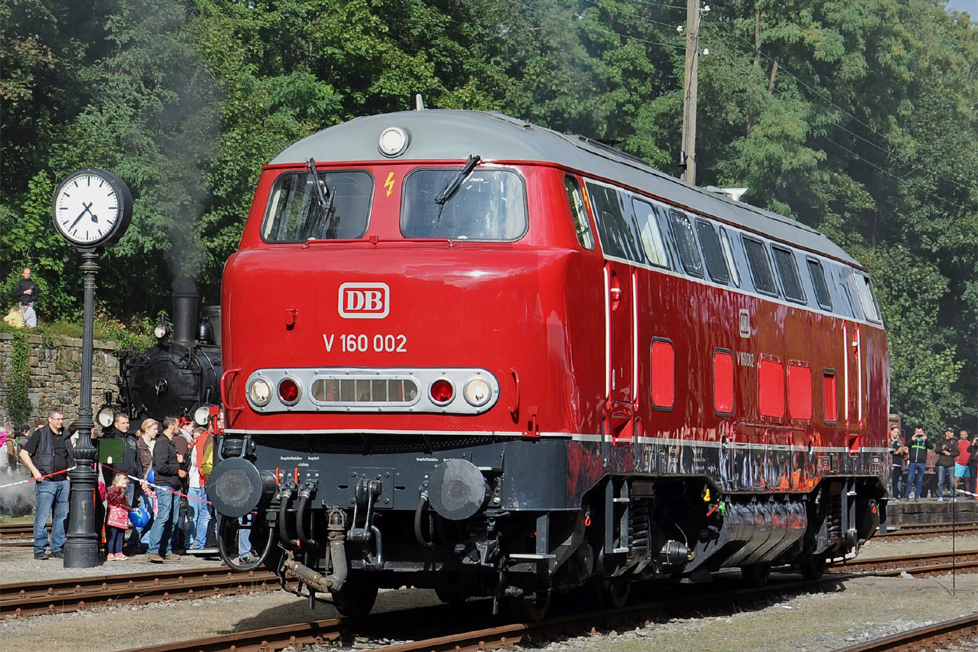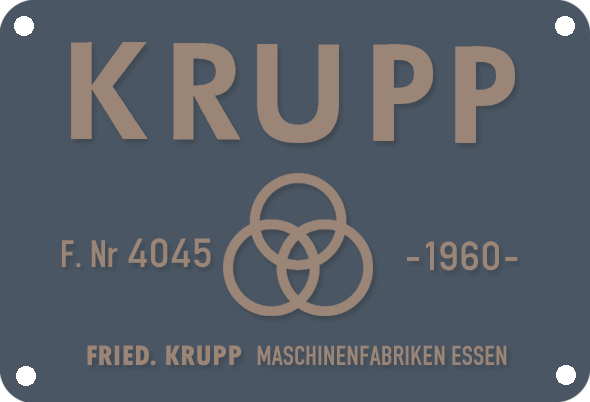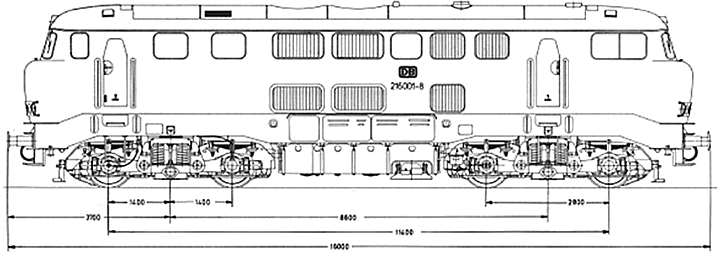|
As early as
1956, the development of the V 160 series began at the Krupp
locomotive factory in Essen in cooperation with the then Deutsche
Bundesbahn.
New
high-performance locomotives were urgently needed – on the one hand
due to the steadily increasing transport services due to the
increasing economy, but also due to the very outdated stock of steam
locomotives, some of which still dated back to the time of the
Länderbahn. Even then, efforts were made to procure no more new steam
locomotives, but modern diesel and electric locomotives, which on the
one hand have a higher degree of efficiency, but on the other hand
also require a significantly lower infrastructure and lower personnel
costs. Good experience had already been gained with the V 200 series,
which entered service in 1953 and was incorporated into the
development of the V 160.
The diesel
locomotives of the V 160 series were intended for passenger and
freight train service and were well equipped for this with their 1900
hp and a top speed of 120 km/h. Numerous locomotives of this class
were equipped with push-pull control. At that time, many passenger
coaches still had steam heating systems and the V 160 had a steam
boiler of the type Vapor-Heating OK4616 to supply the heaters of the
passenger coaches, but also to preheat or keep the engine system warm.
For this purpose, the locomotives carried a supply of 3,000 litres of
water.
The first 9
pre-production locomotives V 160 001 to 009 were given the round shape
of the stems, which earned them the nickname "Lollo" in allusion to
the Italian actress Gina Lollobrigida, who was very popular in the
1950s. From the V 160 010 onwards, the locomotives were given the more
angular front end, which was initially developed for the V 320, but
was also adopted for the V 160 due to simplified and cheaper
production.
With the
exception of the V 160 006, the pre-series engines were equipped with
Maybach MD16V 538TB engines.
Of the Class
V 160 (later Class 216), 214 engines were put into service between
1963 and 1968. The further developments with the classes 210, 215,
217, 218 and 219 reached very high numbers, many of which are still
reliably in service today. Not only at Deutsche Bahn AG, but also at
numerous private railways, these engines can be found, some with
various modifications and in a wide variety of colours.
The ten
pre-production locomotives were retired between 1978 and 1984. One of
them even made it to the TWE afterwards. In the years 1989 and 1993 to
1996, V 160 004 (designated V 216 by the TWE) was often encountered in
front of the steel trains running between Hanekenfähr near Lingen and
Paderborn in a blue-orange livery. In 1996, it was also sold to Italy
and was used there for many years after extensive refurbishment by a
private company in Genoa.
Of the ten pre-series machines, 5, i.e. exactly half, have been
preserved in Germany and abroad.
V 160 002 (from
1968: 216 002-6) was commissioned on 8.12.1960, retired on 28.9.1978
and finally retired on 18.3.1979 and sold to Italy. Here she worked
for a track construction company before she was found in Barcelona,
Spain, two years later.
In 2010, the
locomotive was brought back to Germany by its current owner Albert
Merseburger and refurbished to operational condition and equipped with
Pzb 90 and GSM-R. The visual condition is approximately the same as
the delivery condition of 1960. The locomotive has found a new home in
the Kulturlokschuppen Neumünster.
|
 |

|
Type |
Mainline
diesel locomotive |
|
Design |
B’B’ -
dh |
|
Gauge |
1.435 mm |
|
Manufacturer |
Friedrich Krupp,
Essen |
|
Fabrication
N° |
4045 |
|
Year |
1960 |
|
Length
over buffers |
16.000 mm |
|
Weight |
76,7 t |
|
Engine |
Maybach
MD
16V 538TB |
|
Cylinder |
16 |
|
Power |
1.400 kW
/ 1.900 PS |
|
Power
transmission |
Hydraulic |
|
Fuel supply |
2.700 l |
|
Water supply
( heating ) |
3.000 l |
|
Maximum speed |
120 km/h
(Overdrive) |
|
" |
80 km/h
(Slow gear) |
|
Last running
number |
216 002-6 |
|
Status |
Serviceable
● |
|

 |

![]()
![]()